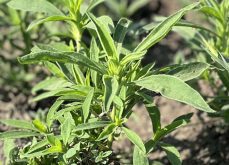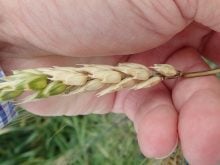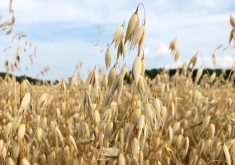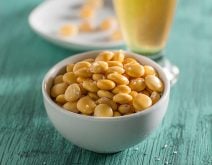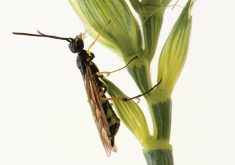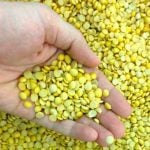Farmers who grow malting barley in their rotation say there is a lot to like about the crop. It’s an early-maturing, drought-resistant crop that competes well with weeds. And if farmers meet the high standards required by malting houses, they can earn a handsome premium.
Although malting barley once yielded significantly less than higher-yielding feed types, this has now changed.
“There’s been a pretty large increase in yield,” says Andrew Hector, cereal crop extension specialist with the Manitoba Crop Alliance. Newer varieties now produce yields close to CDC Austin, the top feed variety, he added.
Read Also

New soil treatment targets saline patches in fields
Crop Aid SS is a Saskatchewan-made spray that’s intended to help farmers manage saline soils by leaching salts away from the root zone.
As a result farmers growing barley for feed are increasingly opting to grow a malting variety, even if it’s just to keep the door open to getting that malting barley premium, which can be as high as $3 per bushel, Hector says.
But he says one of the biggest advantages of growing barley is that it gives farmers more control come harvest time.
“It helps you space out your harvest if equipment or personnel constraints limit your options, offering more time management flexibility,” he says.
Speaking to attendees at the Canadian Malting Barley Technical Centre’s CMBTC Producer Malt Academy course in Winnipeg last fall, Hector notes malting barley fits roughly into the same slot as wheat in a rotation.
“Barley planted after cereal saw relatively low yield compared to something like canola,” he says, adding that in Manitoba over half of barley acres were planted into canola stubble.

Variety selection
A good starting place for variety selection is the CMBTC’s annual Malting Barley Recommended Varieties list.
Established varieties like AAC Synergy and CDC Copeland remain farmer favourites, while newer varieties such as AAC Connect, CDC Fraser, and CDC Churchill are quickly gaining in popularity. As mentioned, these new varieties are high-yielding, but also have better disease resistance and straw strength.
READ ALSO: New cereals on deck for 2025
“Some of the older varieties have poor lodging (resistance), and they didn’t stand as well, but lodging has vastly improved with these new varieties,” Hector says.
The CMBTC recommends growers talk to their malting, grain, or seed company representatives to discuss options for growing malting barley. Farmers should also consult their provincial seed guide.
READ ALSO: New malting barley variety acceptance an uphill battle
Varietal purity
Brewers demand variety purity in order to ensure consistency for their products. Shawn Pasieczka, a food safety grain specialist with Richardson International, said Richardson requests a minimum of 95 per cent purity and tests for it. To meet those standards, he recommends using certified seed.
While Pasieczka says it’s possible to replant seed saved from previous crops, he warned that some buyers require certified seed. Even if the grower works with a company that doesn’t require certified seed, he recommended retesting the seed to ensure purity, and not to plant seed more than two years beyond certification.
Seeding dates
Generally, the recommended dates for planting barley depend on the region and variety, but generally they fall between late April and the end of May.
READ ALSO: Critical factors in growing malting barley
“Seeding early is important if you want to maximize yield,” Hector says, but adds that the timing of seeding also impacts qualities such as protein levels and kernel uniformity and plumpness, which are important to malting companies.
According to the CMBTC, North American brewers prefer protein levels between 10 and 11.5 per cent, while Chinese brewers accept slightly higher levels, up to 13 per cent.
Seeding rates
Hector says the recommended target plant population for malting barley is 22 to 25 plants per square foot. He points to research done by now-retired AAFC crop scientist John O’Donovan that showed that as seeding rate increased, kernel plumpness and protein concentration decreased.
“They found that 300 seeds per metre squared was the optimum seeding rate for yield and malt quality,” Hector says.
Nutrient levels
A 2022 fertilizer use survey showed that nearly all malt barley growers applied nitrogen, typically as urea or anhydrous ammonia.
When making nitrogen rate decisions for malt barley, growers should consult with their agronomists to ensure they’re getting the levels right. The CMBTC recommends soil testing to check nutrient levels.
“There is a balancing act to determining how much nitrogen you should apply,” Hector says. “You need it to reach optimum yield, but excessive nitrogen risks higher than optimum protein levels.”
Diseases
The main diseases barley growers must contend with are scald, fusarium head blight and spot blotch. Disease levels depend on geography. Variety disease packages and cultural control methods can help, but at one point or another, a fungicide application could be necessary, and the proper timing of that application is critical.
“Barley is a little different than wheat in terms of flower timing,” Hector explains. “The label recommendation is typically between 70 and 100 per cent of heads fully emerged on the main stem to three days post head emergence.”
But Hector warns that heads that haven’t emerged will not have made contact with the fungicide and won’t have the coverage. So, he recommended trying to get as close to 100 per cent of heads emerged as possible.
Crop protection products
Malting barley has very strict standards when it comes to residue from crop protection products. Growers should check with the KeepItClean.ca campaign’s annual Product Advisory to ensure they don’t encounter market access issues when selling their grain.
Products restricted for malt barley include the fungicides fluopyram and tetraconazole, the plant growth regulator chlormequat, and the herbicides glyphosate and saflufenacil.




